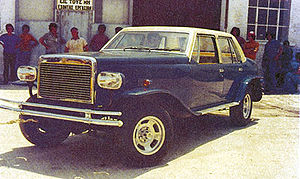
Neorion Chicago
Encyclopedia

Greece
Greece , officially the Hellenic Republic , and historically Hellas or the Republic of Greece in English, is a country in southeastern Europe....
Neorion
Neorion
Neorion is one of the oldest Greek heavy industries, located in Ermoupolis, on the Greek island of Syros. Today, it is one of the few remaining major industrial corporations in that picturesque and nostalgic island town that used to be the industrial and commercial heart of Greece, before being...
group of companies, was a car supposed to combine uncompromising luxury, retro-looks and a powerful 4x4, cross-country character. The end result was, at best, one of the most controversial cars ever built.
History
In 1972, under the ownership of the Greek millionaire Giannis Goulandris, NeorionNeorion
Neorion is one of the oldest Greek heavy industries, located in Ermoupolis, on the Greek island of Syros. Today, it is one of the few remaining major industrial corporations in that picturesque and nostalgic island town that used to be the industrial and commercial heart of Greece, before being...
incorporated Enfield Automotive
Enfield Automotive
Enfield Automotive was an electric car manufacturer founded in the United Kingdom in the 1960s. Under the ownership of Greek millionaire Giannis Goulandris, production was moved to the Greek isle of Syros during the oil crisis of 1973.-Enfield 465:...
, originally a British
United Kingdom
The United Kingdom of Great Britain and Northern IrelandIn the United Kingdom and Dependencies, other languages have been officially recognised as legitimate autochthonous languages under the European Charter for Regional or Minority Languages...
company, already owned by Mr. Goulandris, involved in the design and construction of electric cars. This led to the creation of a new company which undertook vehicle production, "Enfield-Neorion E.P.E.", headquartered in Piraeus
Piraeus
Piraeus is a city in the region of Attica, Greece. Piraeus is located within the Athens Urban Area, 12 km southwest from its city center , and lies along the east coast of the Saronic Gulf....
, and production of the cars (which had been designed in the UK by British and Greek engineers) was transferred to Syros
Syros
Syros , or Siros or Syra is a Greek island in the Cyclades, in the Aegean Sea. It is located south-east of Athens. The area of the island is . The largest towns are Ermoupoli, Ano Syros, and Vari. Ermoupoli is the capital of the island and the Cyclades...
, where Neorion
Neorion
Neorion is one of the oldest Greek heavy industries, located in Ermoupolis, on the Greek island of Syros. Today, it is one of the few remaining major industrial corporations in that picturesque and nostalgic island town that used to be the industrial and commercial heart of Greece, before being...
is based.
Apart from the production of the electric cars, Mr. Goulandris wished to develop "conventional" cars of his own. One of his personal visions was an odd mixture of a luxurious, retro-styled limousine with a very strong cross-country character and capabilities. The design and overall development of the car was assigned to a team of Greek engineers, headed by Georgios Michael
Georgios Michael
Georgios Michael is a Greek industrial designer.He studied architecture in Thessaloniki and made his first steps in industrial design in Italy, working for Sergio Coggiola and Carrozzeria Ghia...
, a car designer.
After eight months of development work, the Chicago, as the 4x4 car was named (the name inspired by its 30s retro-style), was introduced in 1974. The construction included a robust chassis built by the Neorion shipyard and an aluminum body on a steel frame, that incorporated particular reinforcements for passenger protection. Power came from an AMC
American Motors
American Motors Corporation was an American automobile company formed by the 1954 merger of Nash-Kelvinator Corporation and Hudson Motor Car Company. At the time, it was the largest corporate merger in U.S. history.George W...
/Jeep
Jeep
Jeep is an automobile marque of Chrysler . The first Willys Jeeps were produced in 1941 with the first civilian models in 1945, making it the oldest off-road vehicle and sport utility vehicle brand. It inspired a number of other light utility vehicles, such as the Land Rover which is the second...
(Wagoneer) V8 engine.
Early sketches by Michael suggested a more elegant limousine with a strong retro-look. However, the final design was significantly altered to accommodate the American mechanical parts and cope with the desired cross-country capabilities, and looked rather awkward. In fact, its own designer tried to distance himself from the car (which he often described as a "mountain dinosaur"), arguing that Mr. Goulandris had essentially dictated its basic elements.
Today, in view of the 4x4 passenger cars that have appeared ever since, the retro-look fashion, as well as the breed of luxury SUVs, the car does not look terribly strange anymore; one could actually say that it was ahead of its time (being the second luxury SUV in the world after the Range Rover
Range Rover
The Range Rover is a large luxury four-wheel drive sport utility vehicle produced by British car maker Land Rover. The model, launched in 1970, is now in its third generation...
). In more recent publications, even Mr. Michael seems to have finally given some credit to his own creation.
A production line had been started with four vehicles at various stages of construction, when a change of Greek law condemned the market prospects of the car. Only two complete vehicles were made and sold before the venture was terminated in 1976. At least one still survives to date and is exhibited in the Thessaloniki Technological Museum; the second car is believed to have ended up in a private collection abroad.

